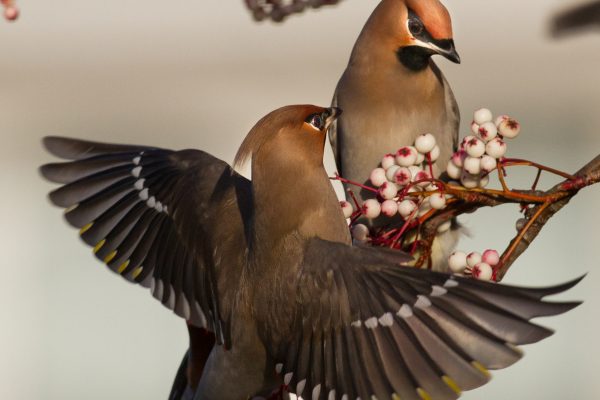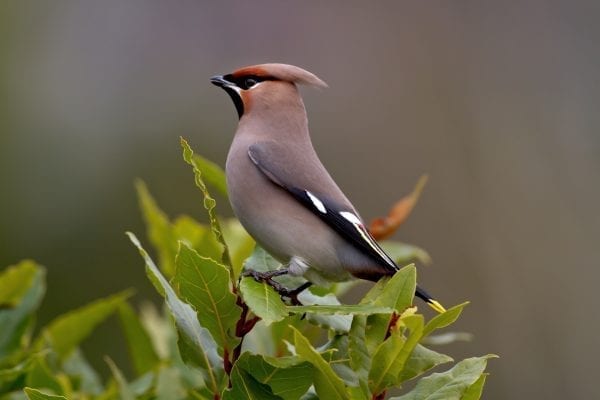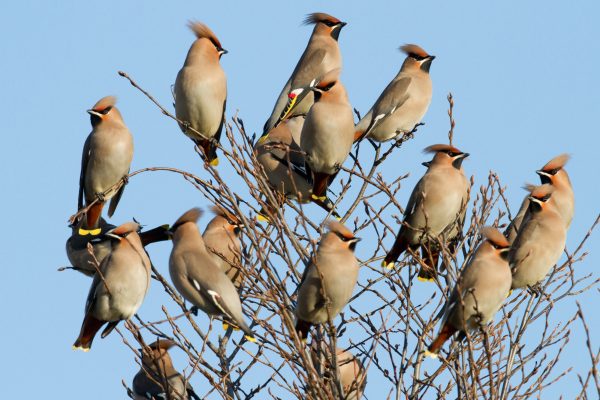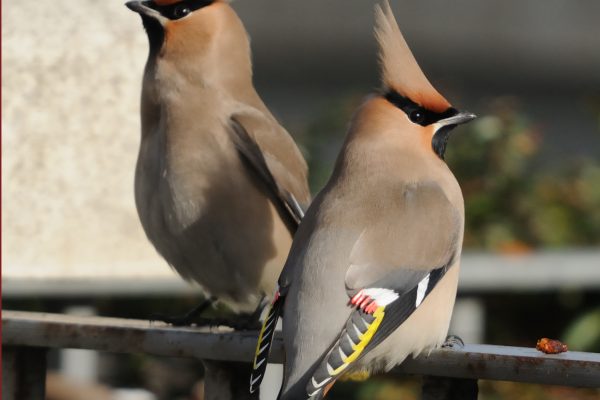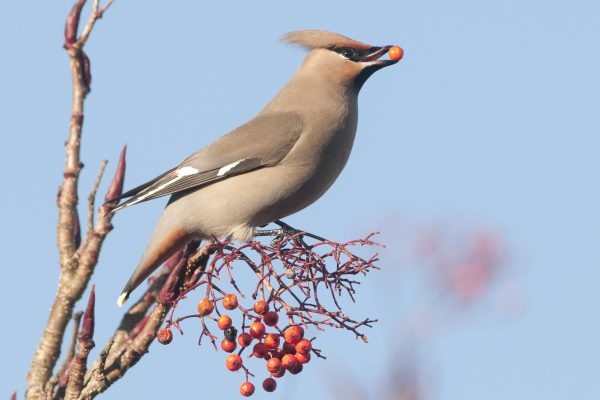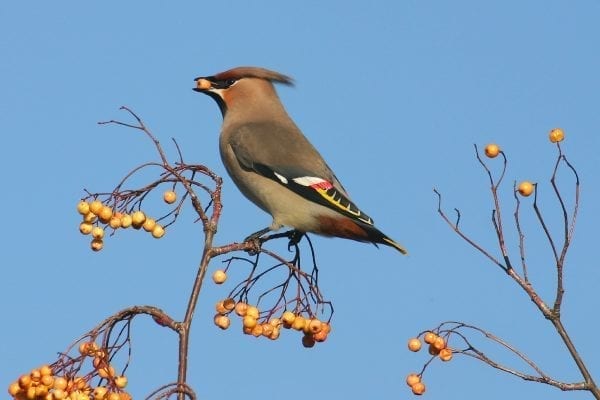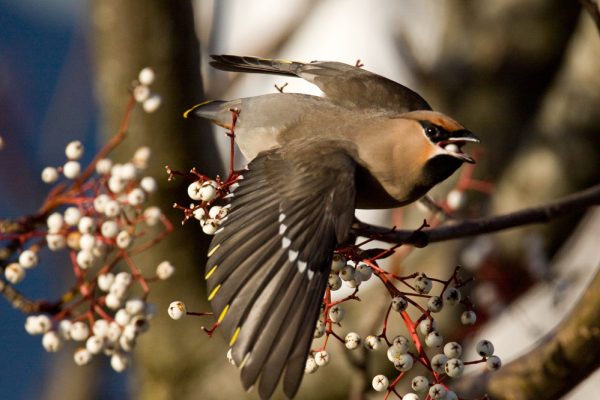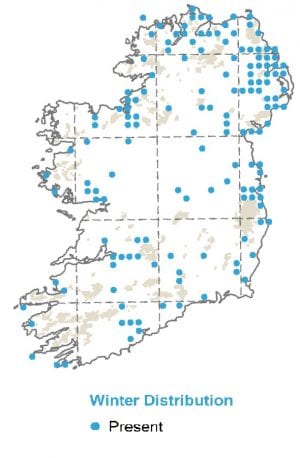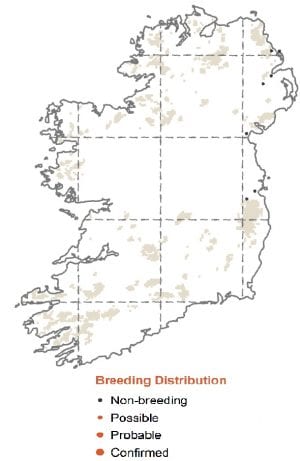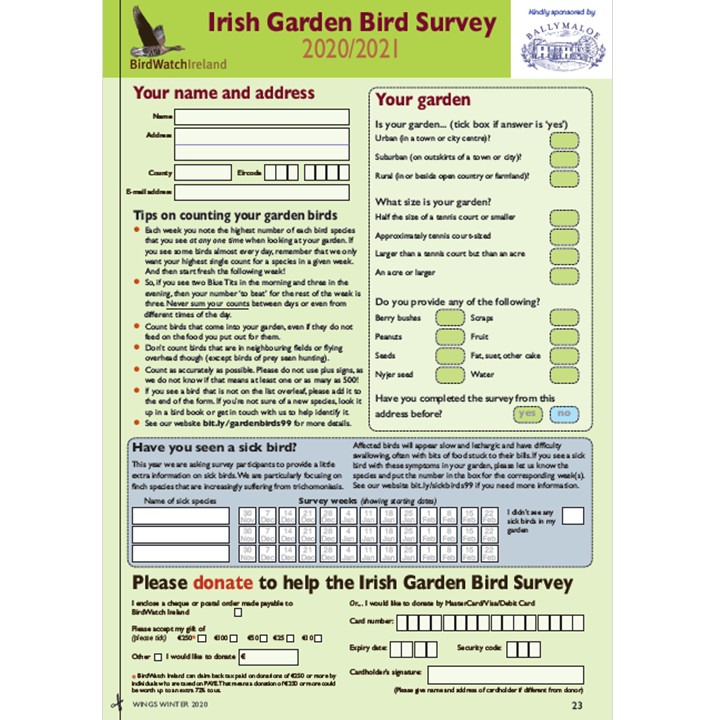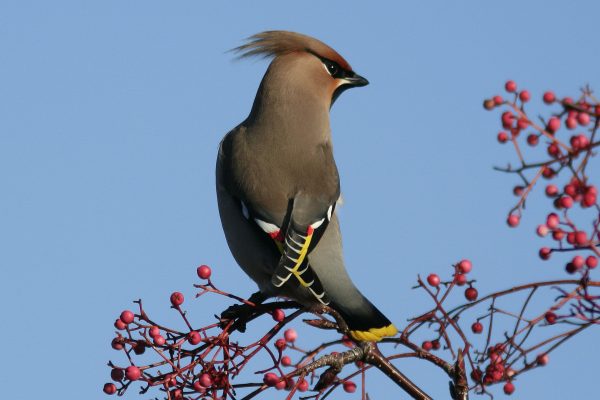
Waxwing
| Irish Name: | Síodeiteach |
| Scientific name: | Bombycilla garrulus |
| Bird Family: | Waxwings |
green
Conservation status
Conservation status
Status
Winter visitor in variable numbers to urban areas, mainly to the north and east of Ireland. Occasional larger influxes.
Identification
Slightly larger than a Bullfinch. The body is a uniform light brown colour, with small black patches around the eye and on the chin. The vent is dark red in colour, while there is a thin white stripe on the wing. Just below this white stripe is a small group of red feathers similar to a blob of wax, which gives the Waxwing its name. It is also one of the very few birds likely to turn up in Irish gardens which has an obvious crest.
Voice
A high-pitched, almost bell-like “sirrr”.
Diet
Feeds almost exclusively on berries during the winter, mainly those of Rowan and Pyracantha. Waxwings will also feed on apples that have been cut in half and speared on branches. In summer, Waxwings feed on insects caught in flight.
Breeding
Does not breed in Ireland. The breeding range extends from Finland eastwards across Siberia and into northernmost North America.
Wintering
Winters mainly in southern Scandinavia, with only a few sightings in Ireland every year. Every few years there is a larger invasion into Ireland when the food supplies in their normal winter range is exhausted prematurely. Normally seen in groups of five to fifty birds, but flocks of up to 400 Waxwings have been recorded in Ireland.
Monitored by
Blog posts about this bird
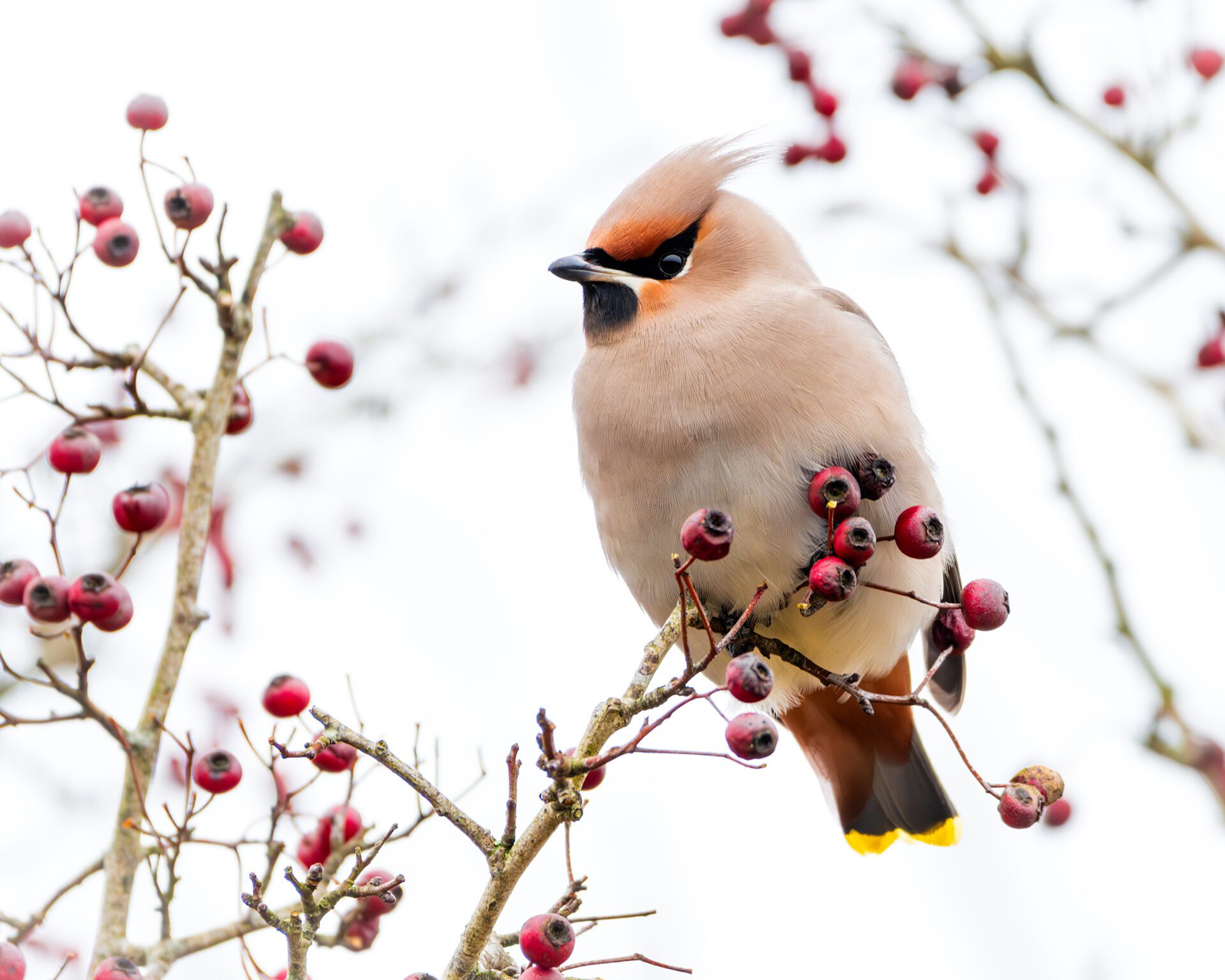
A welcome Waxwing winter
Waxwing in Tomhaggard, Co. Wexford. Photo: Declan Roche.
Winter brings with it much anticipation as people prepare for festivities with family and friends. Will we have a white Christmas? Will your visiting Aunt cause a commotion over Christmas dinner again? Will you remember to buy the cranberry sauce this time? For birders in Ireland and the UK, there’s another question that comes around as predictably as the season itself each year – will we have a Waxwing winter? For those unfamiliar, a Waxwing winter is one in which there is an influx of Waxwings to the country. This is a phenomenon that can’t be taken for granted. After all, this is a bird that usually winters in Southern Scandinavia, while its breeding range extends from Finland eastwards across Siberia and into northernmost North America.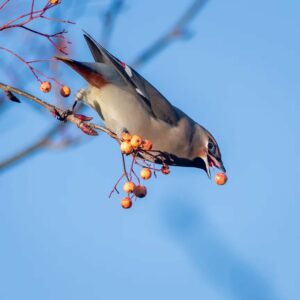
Waxwing in Glenealy, Co. Wicklow. Photo: John Murphy.
So, why do these birds end up in Ireland at all? It all comes down to berries. In winter, Waxwings are highly dependent on berries as a food source and feed almost exclusively on them, mainly those of Rowan and Pyracantha. These birds are so dependent on berries as a food source, in fact, that they are quite literally willing to go the extra mile to get them. When berry supplies in their usually wintering countries are exhausted prematurely – something which can often happen during a good Waxwing breeding season – these birds will travel south in search of food. Such was the case this year. In the past number of weeks, people around the country have been gleefully reporting sightings of these stunning birds. With their perfectly coiffed crest, black bandit mask and red wax-like droplets on their wing feathers, these birds look like something you would see on the front of a Christmas card.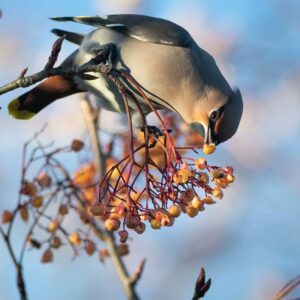
Waxwing in Glenealy, Co. Wicklow. Photo: John Murphy.
Just as many of us enjoy devouring mince pies and chocolate over the winter period, so too do Waxwings like to indulge in their favourite foodstuffs. Studies have shown that Waxwings can eat up to three times their own body weight in berries a day. As a flock – known as a “museum of Waxwings” – can clear a shrub or tree of berries very quickly, they won’t spend too long at any one location. With that in mind, if you hear that there are Waxwings in your area, try to get out to see them as soon as you can!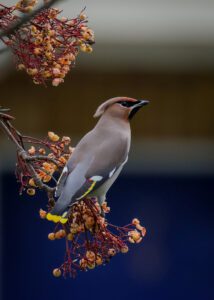
Waxwing in Islandbridge, Dublin. Photo: Paul Campbell.
In recent weeks, Waxwings have been spotted in Glenealy, Co. Wicklow, Knocklyon, Co. Dublin, Ballycastle, Co. Antrim and several other places. If you want to catch a glimpse of them this winter, they are often seen in supermarket car parks, town centres, gardens, and anywhere else with berry-laden trees and shrubs. If you see a Waxwing this winter, we would love to hear from you and see your images. Please send photos and videos to us via social media, or to alewis@birdwatchireland.ie. We will be sure to credit you by name should we share them.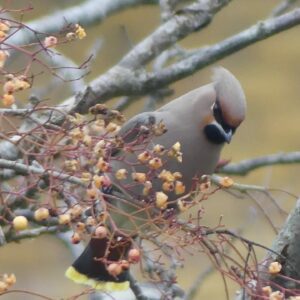
Waxwing in Islandbridge, Dublin. Photo: Darren's Wildlife Photos.
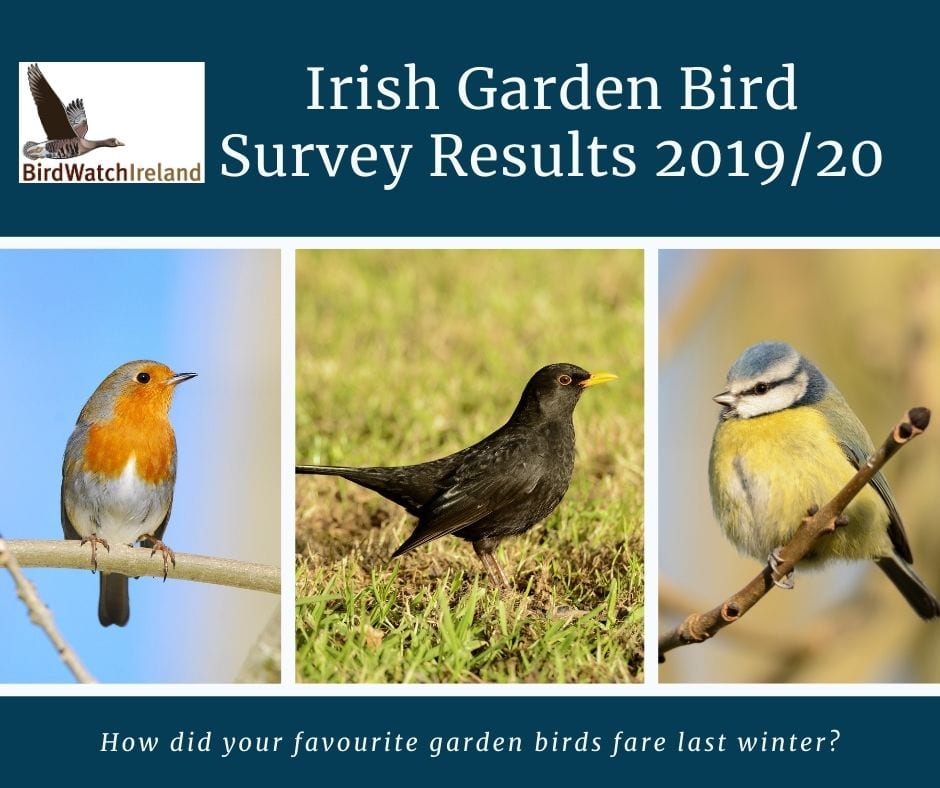
Irish Garden Bird Survey - Results from Winter 2019/20
The Irish Garden Bird Survey is the biggest and longest-running survey of it's kind in Ireland. We need as many people as possible all over the country to take part this winter. Taking part couldn't be easier - See here for details on how to participate this winter - and see below for what last year brought for Ireland's favourite garden birds.
The Irish Garden Bird Survey is kindly sponsored by Ballymaloe. Click below to learn about taking part this winter.
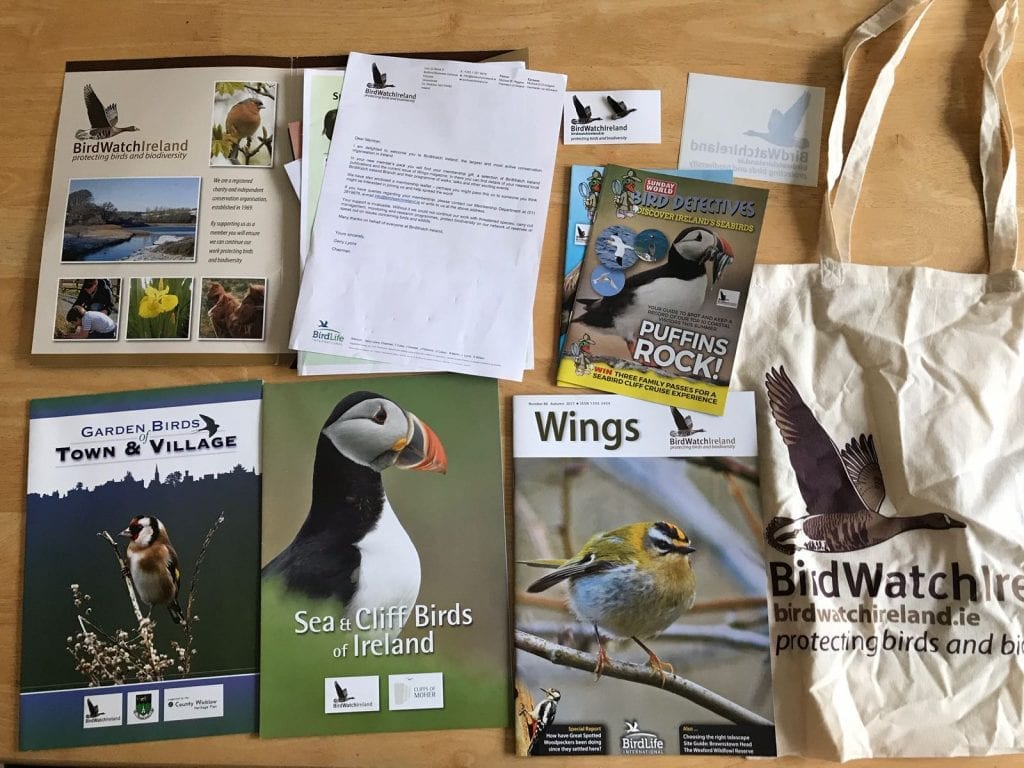
An example of the type of things you receive in your welcome pack when you first join as a BirdWatch Ireland member.
If you’re a BirdWatch Ireland member, you’ll have already received these results in the winter edition of Wings magazine that would have arrived in the post at the start of November. If you’re not a BirdWatch Ireland member you can still take part in the survey (and we urge you to!), but if you go the extra step and become a member you won’t regret it! You’ll receive a welcome pack full of information about Ireland’s birds, including a garden birds poster with loads of advice on how to look after birds in your garden. You’ll also get our Wings magazine four times per year – the gift that keeps on giving! And if you opt for a family membership, there’s our kids magazine ‘Bird Detectives’ twice a year too. Membership makes a fantastic gift for family or friends, and you’ll be supporting Ireland’s largest wildlife conservation charity in the process! (click here to see the different membership options available)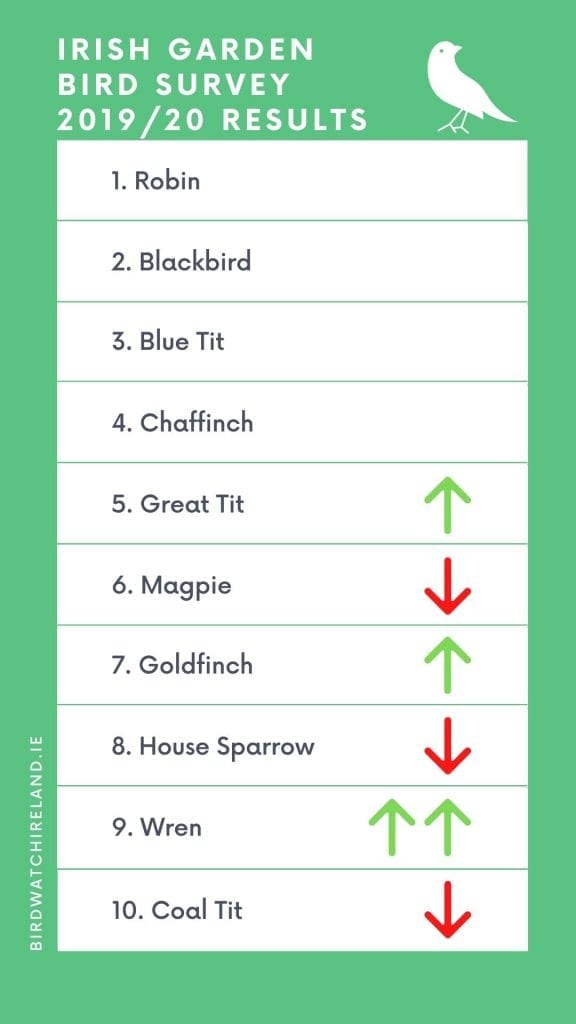 Top 10 Irish Garden Birds
One of the most important things about last winter, from a birds point of view, is that it was pretty mild throughout. On top of that, the winter before was much the same. As a result, no birds were particularly hard-hit by frost or snow, and many birds continued their recovery from the 'Beast from the East' a couple of winters previous.
For the tenth year in a row, the Robin was the most common bird in Irish Gardens last winter – seen in 99.8% of gardens! Blackbird and Blue Tit were close behind, and the sheer abundance of these birds in the Irish countryside means they’re more often than not the top 3 birds recorded each year. Outside the top 3, Chaffinch held on to 4th place, and Great Tit moved up one to get into the top 5. That meant Magpie lost out and was relegated to 6th, though were still seen in 90% of gardens. After that we have the ever-popular Goldfinch which moved up to 7th, their highest ever position in the rankings table. It wasn’t until winter 2000/01 that Goldfinch managed to break into the top 20, but it has spent 9 of the last 10 winters in the top 10 and is going from strength to strength. House Sparrow are a pretty robust and tough bird, so they always tend to do well, though are absent from areas where there’s no suitable nest site in the summer, as they don’t tend to move far even in the winter. Wren, as our second-smallest bird, are still recovering from the Beast from the East a few winters back but jumped up two places to 9th last winter. And finally, the always-active Coal Tit dropped one position but still stayed in the top 10. In Ireland we have our own subspecies of Coal Tit, and reports from around the country this autumn suggest that they’ve had a very good year – so I’m predicting they might climb up a few places in the table this winter!
Top 10 Irish Garden Birds
One of the most important things about last winter, from a birds point of view, is that it was pretty mild throughout. On top of that, the winter before was much the same. As a result, no birds were particularly hard-hit by frost or snow, and many birds continued their recovery from the 'Beast from the East' a couple of winters previous.
For the tenth year in a row, the Robin was the most common bird in Irish Gardens last winter – seen in 99.8% of gardens! Blackbird and Blue Tit were close behind, and the sheer abundance of these birds in the Irish countryside means they’re more often than not the top 3 birds recorded each year. Outside the top 3, Chaffinch held on to 4th place, and Great Tit moved up one to get into the top 5. That meant Magpie lost out and was relegated to 6th, though were still seen in 90% of gardens. After that we have the ever-popular Goldfinch which moved up to 7th, their highest ever position in the rankings table. It wasn’t until winter 2000/01 that Goldfinch managed to break into the top 20, but it has spent 9 of the last 10 winters in the top 10 and is going from strength to strength. House Sparrow are a pretty robust and tough bird, so they always tend to do well, though are absent from areas where there’s no suitable nest site in the summer, as they don’t tend to move far even in the winter. Wren, as our second-smallest bird, are still recovering from the Beast from the East a few winters back but jumped up two places to 9th last winter. And finally, the always-active Coal Tit dropped one position but still stayed in the top 10. In Ireland we have our own subspecies of Coal Tit, and reports from around the country this autumn suggest that they’ve had a very good year – so I’m predicting they might climb up a few places in the table this winter!
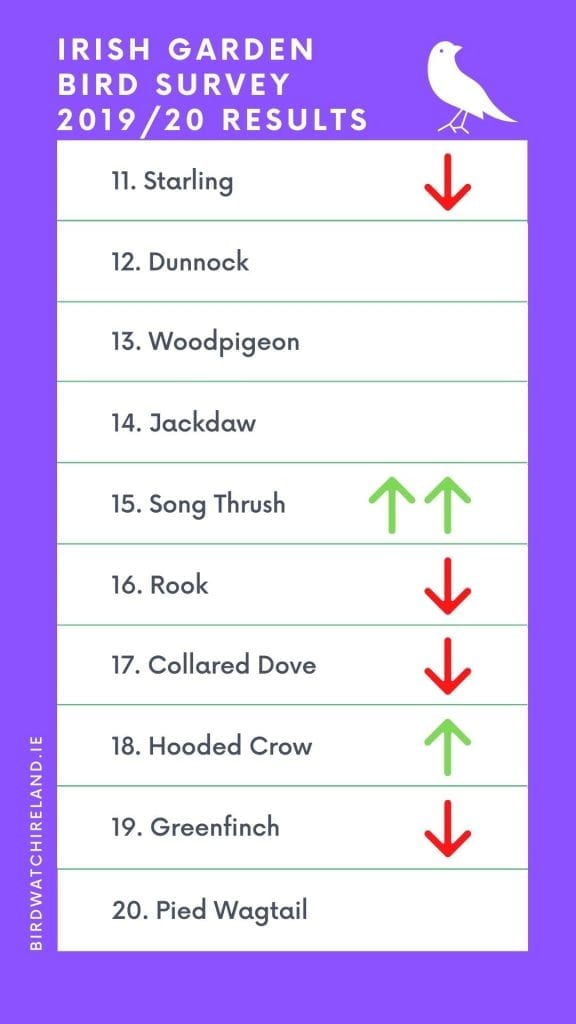 Top 20 Irish Garden Birds
As we move down the table, there’s always a bit more movement from year to year. Starling had previously been in the top 10 but dropped out last year. Dunnock and Woodpigeon kept the same positions as the previous year, and occurred in over 70% of Irish gardens. Song Thrush, another species that tends to get hit quite badly by snowy winters, moved up two places to 15th. It’s a good indication that a bad winter every now and again is ok – our birds have evolved to cope with that. The more bad years we have in a row though, means they don’t have a chance to recover before getting hit hard again. The two consecutive cold winters around 2010 and 2011 really hit some of our birds quite badly, including Song Thrush. Further down the table, Hooded Crow have gradually moved up the table over the lifetime of the Irish Garden Bird Survey, and last year was their best year yet – reaching 18th in the rankings table and occurring in 60% of Irish gardens. This is probably down to a genuine increase in their numbers nationally in recent years, as well as increased use of gardens. Pied Wagtail retained their spot in the top 20, occurring in 54% of Irish Gardens. Interestingly, if we delve a bit deeper, we see that they occurred in over 70% of rural gardens last year, but only 30-35% of urban and suburban gardens. That’s why we ask whether your garden is in an urban/suburban/rural garden as part of the survey – different species show different patterns of distribution and behaviour and it’s important we capture that!
Other interesting results from last winter include the small species like Long-tailed Tit (23rd place) and Goldcrest (24th) jumping several places up the rankings table, seemingly a continued recovery after their numbers were hit by the snow during the 'Beast from the East' a few years ago. Another highlight was the first recording of Ring-necked Parakeets in Irish gardens, the continued increase in the number of gardens and counties that have had visits from Great-spotted Woodpeckers. What will this winter bring? A Waxwing winter? A bounty of Bramblings? The more people taking part in the survey, the more we'll find out!
Top 20 Irish Garden Birds
As we move down the table, there’s always a bit more movement from year to year. Starling had previously been in the top 10 but dropped out last year. Dunnock and Woodpigeon kept the same positions as the previous year, and occurred in over 70% of Irish gardens. Song Thrush, another species that tends to get hit quite badly by snowy winters, moved up two places to 15th. It’s a good indication that a bad winter every now and again is ok – our birds have evolved to cope with that. The more bad years we have in a row though, means they don’t have a chance to recover before getting hit hard again. The two consecutive cold winters around 2010 and 2011 really hit some of our birds quite badly, including Song Thrush. Further down the table, Hooded Crow have gradually moved up the table over the lifetime of the Irish Garden Bird Survey, and last year was their best year yet – reaching 18th in the rankings table and occurring in 60% of Irish gardens. This is probably down to a genuine increase in their numbers nationally in recent years, as well as increased use of gardens. Pied Wagtail retained their spot in the top 20, occurring in 54% of Irish Gardens. Interestingly, if we delve a bit deeper, we see that they occurred in over 70% of rural gardens last year, but only 30-35% of urban and suburban gardens. That’s why we ask whether your garden is in an urban/suburban/rural garden as part of the survey – different species show different patterns of distribution and behaviour and it’s important we capture that!
Other interesting results from last winter include the small species like Long-tailed Tit (23rd place) and Goldcrest (24th) jumping several places up the rankings table, seemingly a continued recovery after their numbers were hit by the snow during the 'Beast from the East' a few years ago. Another highlight was the first recording of Ring-necked Parakeets in Irish gardens, the continued increase in the number of gardens and counties that have had visits from Great-spotted Woodpeckers. What will this winter bring? A Waxwing winter? A bounty of Bramblings? The more people taking part in the survey, the more we'll find out!
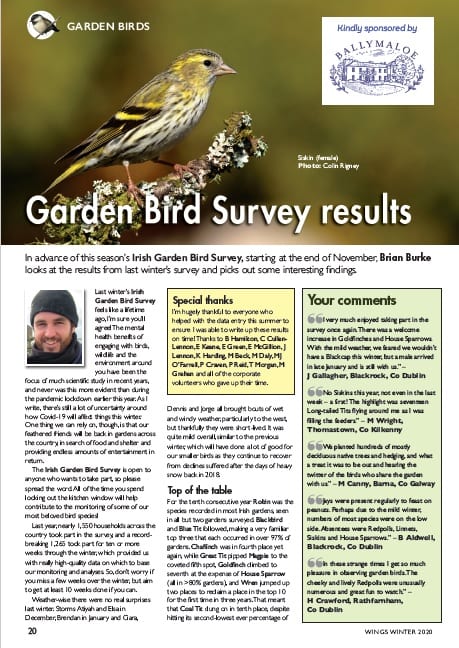
A full and detailed account of last year's Irish Garden Bird Survey results is featured in a three page article in our Wings magazine, sent out to members this winter.
So that’s just a flavour of what the Irish Garden Bird Survey tells us each year. If you’re a member, your Wings magazine will give you the top 30 list as well as additional details on many of the species and trends we’ve seen. If you’re not a member, then take a look at the different membership options, and remember – it makes for a much better Christmas gift than socks or scarves!!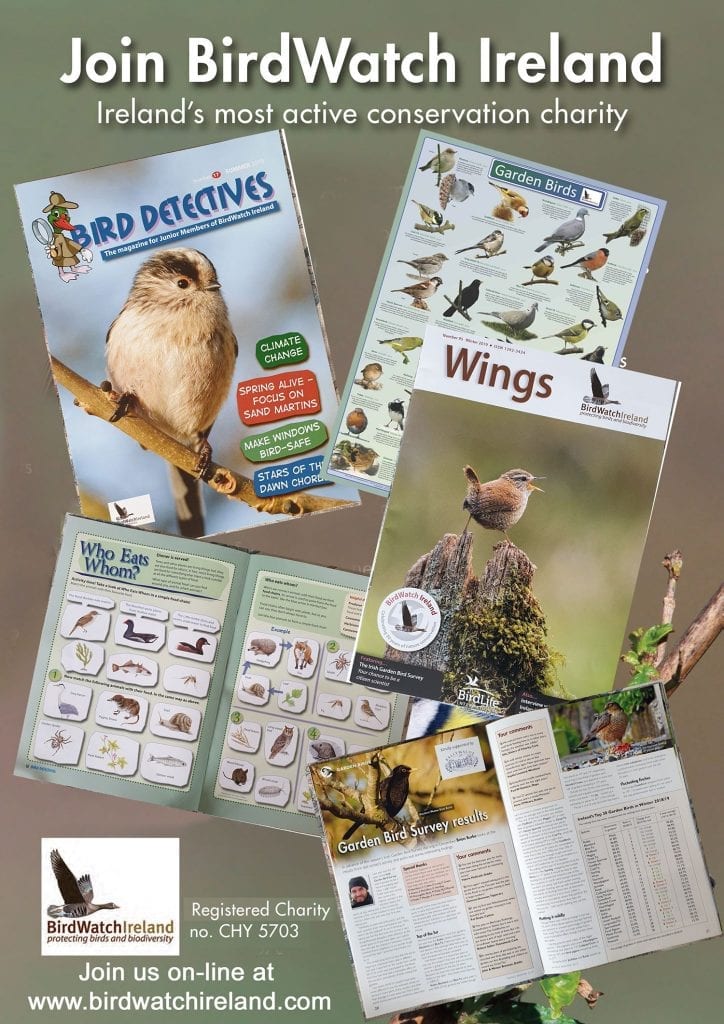
The Irish Garden Bird Survey is running right now and taking part couldn't be easier! Click here for full details about the survey as well as as advice on caring for your birds through the winter.
This winter we're running a series of blogs like this one, filled with facts and figures about your favourite garden birds, click here for more.
We are hugely grateful to Ballymaloe for their sponsorship and support of the Irish Garden Bird Survey.
Click below to download your count form for this year's Irish Garden Bird Survey.

